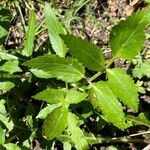Fibrous-rooted from a very short erect crown; stem solitary, angular, stout, to 2 m; principal lvs with 7–17 linear to lance-ovate lfls 5–10 cm, sharply serrate, the primary lateral veins bearing no obvious relationship to the teeth or sinuses; submersed lvs, if present, bipinnately dissected; umbels 3–12 cm wide; bracts and bractlets usually 5 or 8; fr oval, 2–3 mm, nearly as wide; carpophore wanting; 2n=12. Sunny wet meadows and swamps; Nf. to Alas. and Siberia, s. to Fla. and Calif. July–Sept. (S. floridanum, a lax shade-form; S. carsonii, a lax aquatic form with few lfls or even simple lvs)
A herb that keeps growing from year to year. It grows 50-120 cm high. The stems are stout and ribbed. A cluster of long, fleshy roots arise from the base of the stem. The leaves are alternate and compound. They have 7-13 leaflets that have fine teeth along the edge. These are 4-10 cm long. The flowers are small and white. They are in umbrella shaped heads.


